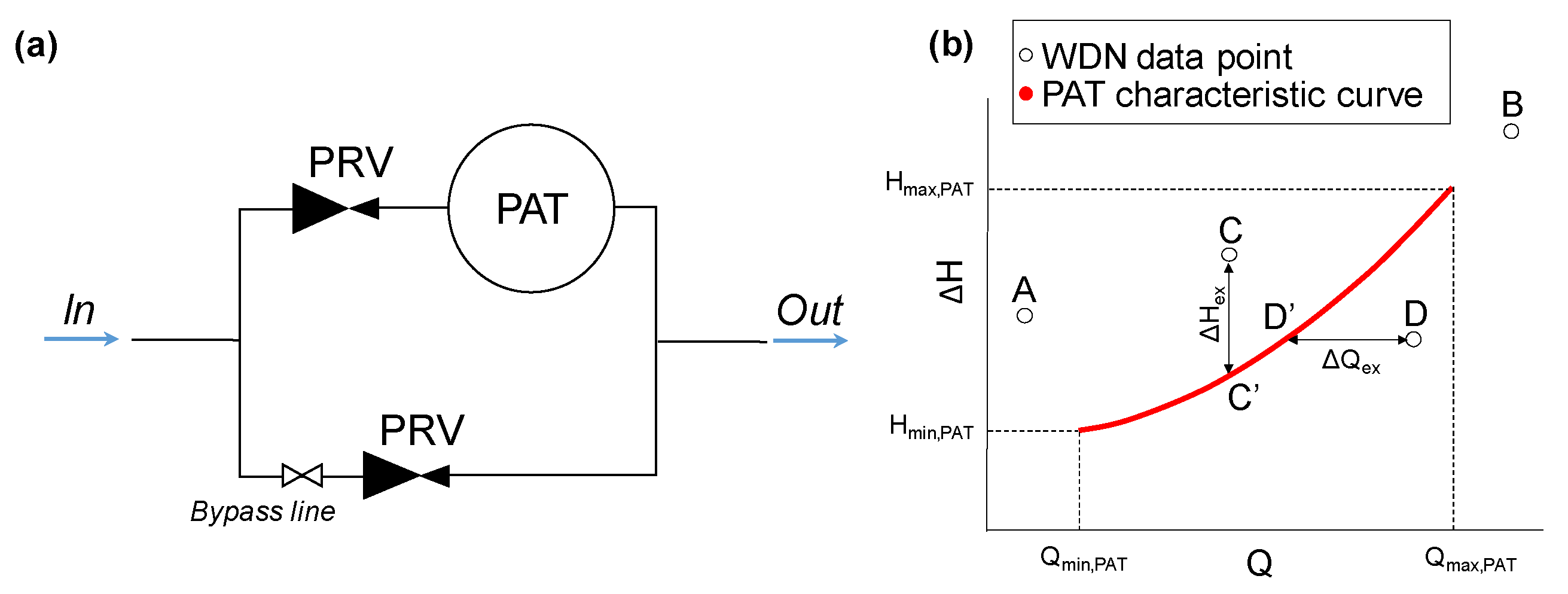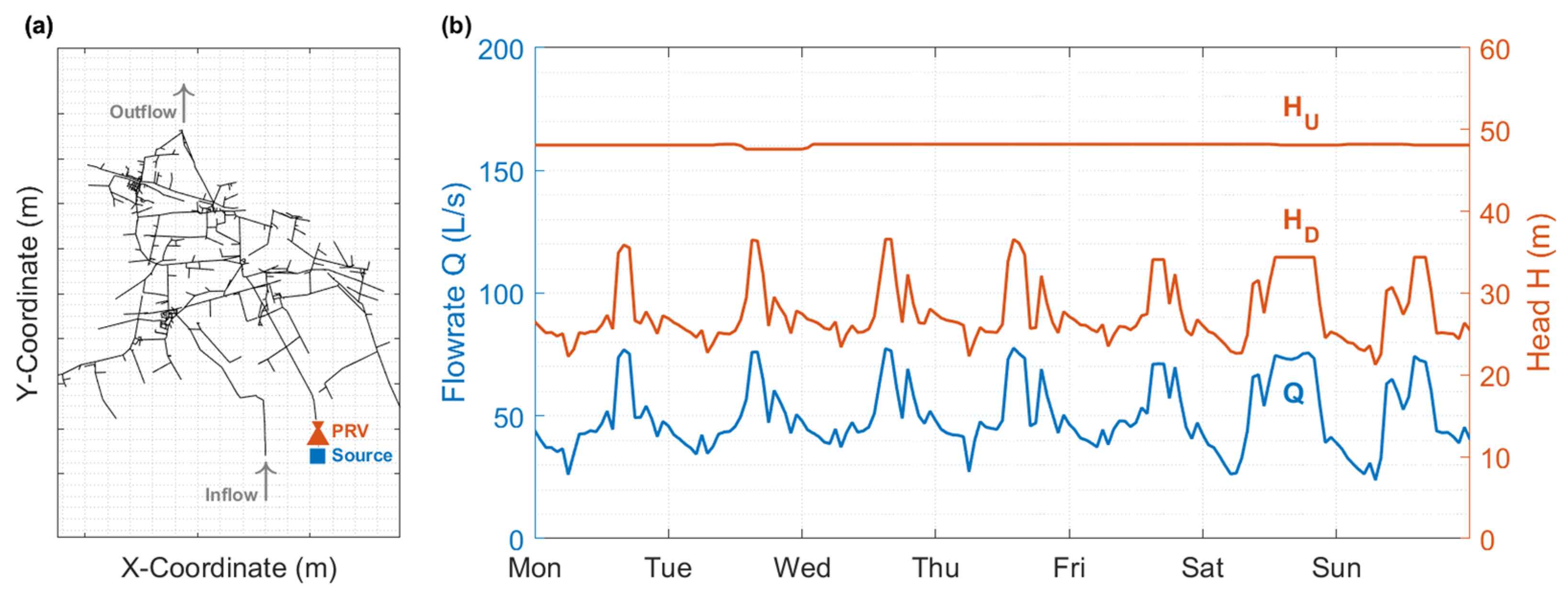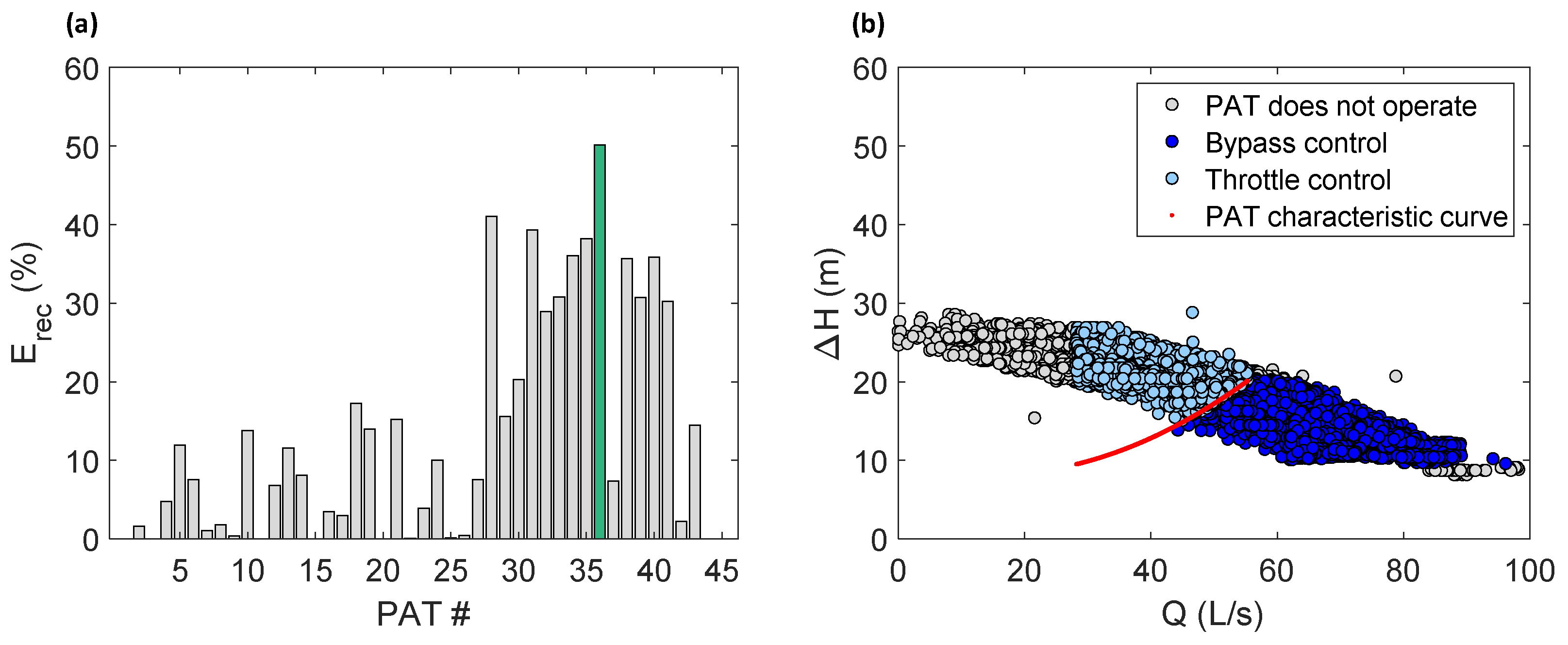Pressure Management in Water Distribution Networks by Means of Pumps as Turbines: A Case Study in Northern Italy †
Abstract
:1. Introduction
2. Materials and Methods
2.1. PAT Selection and Control
- if a given operation point of the WDN falls outside the PAT operation range (e.g., points A and B in Figure 1b), the entire hydraulic energy of WDN is wasted (i.e., the flowrate is fully bypassed).
- if a given operation point of the WDN falls above the head-drop characteristic curve of a given PAT (e.g., point C in Figure 1b), throttle control is applied [8]. The PAT swallows the entire available flow rate in the WDN, while the PRV dissipates the exceeding head-drop (ΔHex in Figure 1b), by wasting a fraction of WDN hydraulic energy [7].
- if a given operation point of the WDN falls below the head-drop characteristic curve of a given PAT (e.g., point D in Figure 1b), bypass control is applied [8]. In this case, PAT’s head-drop is equal to the WDN’s head-drop, while the exceeding flowrate (ΔQex in Figure 1b) is delivered through the bypass line, by wasting a fraction of WDN hydraulic energy [7].
2.2. Case Study
3. Results
4. Conclusions
Author Contributions
Funding
Institutional Review Board Statement
Informed Consent Statement
Data Availability Statement
Conflicts of Interest
References
- Carravetta, A.; Del Giudice, G.; Fecarotta, O.; Ramos, H. Energy Production in Water Distribution Networks: A PAT Design Strategy. Water Resour. Manag. 2012, 26, 3947–3959. [Google Scholar] [CrossRef]
- Sammartano, V.; Arico, C.; Carravetta, A.; Fecarotta, O.; Tucciarelli, T. Banki-michell optimal design by computational fluid dynamics testing and hydrodynamic analysis. Energies 2013, 6, 2362–2385. [Google Scholar] [CrossRef]
- Venturini, M.; Alvisi, S.; Simani, S.; Manservigi, L. Energy Production by Means of Pumps As Turbines in Water Distribution Networks. Energies 2017, 10, 1666. [Google Scholar] [CrossRef]
- Venturini, M.; Manservigi, L.; Alvisi, S.; Simani, S. Development of a physics-based model to predict the performance curves of pumps as turbines. Appl. Energy 2018, 231, 343–354. [Google Scholar] [CrossRef]
- Castorino, G.A.M.; Manservigi, L.; Barbarelli, S.; Losi, E.; Venturini, M. Development and validation of a comprehensive methodology for predicting PAT performance curves. Energy 2023, 274, 127366. [Google Scholar] [CrossRef]
- Marini, G.; Di Menna, F.; Maio, M.; Fontana, N. HYPER: Computer-Assisted Optimal Pump-as-Turbine (PAT) Selection for Microhydropower Generation and Pressure Regulation in a Water Distribution Network (WDN). Water 2023, 15, 2807. [Google Scholar] [CrossRef]
- Manservigi, L.; Venturini, M.; Losi, E.; Castorino, G.A.M. Optimal Selection and Operation of Pumps As Turbines for Maximizing Energy Recovery. Water 2023, 15, 4123. [Google Scholar] [CrossRef]
- Gulich, J.F. Centrifugal Pumps, 3rd ed.; Springer: Berlin/Heidelberg, Germany, 2014. [Google Scholar]



Disclaimer/Publisher’s Note: The statements, opinions and data contained in all publications are solely those of the individual author(s) and contributor(s) and not of MDPI and/or the editor(s). MDPI and/or the editor(s) disclaim responsibility for any injury to people or property resulting from any ideas, methods, instructions or products referred to in the content. |
© 2024 by the authors. Licensee MDPI, Basel, Switzerland. This article is an open access article distributed under the terms and conditions of the Creative Commons Attribution (CC BY) license (https://creativecommons.org/licenses/by/4.0/).
Share and Cite
Manservigi, L.; Marsili, V.; Mazzoni, F.; Castorino, G.A.M.; Farsoni, S.; Losi, E.; Alvisi, S.; Bonfè, M.; Franchini, M.; Spina, P.R.; et al. Pressure Management in Water Distribution Networks by Means of Pumps as Turbines: A Case Study in Northern Italy. Eng. Proc. 2024, 69, 135. https://doi.org/10.3390/engproc2024069135
Manservigi L, Marsili V, Mazzoni F, Castorino GAM, Farsoni S, Losi E, Alvisi S, Bonfè M, Franchini M, Spina PR, et al. Pressure Management in Water Distribution Networks by Means of Pumps as Turbines: A Case Study in Northern Italy. Engineering Proceedings. 2024; 69(1):135. https://doi.org/10.3390/engproc2024069135
Chicago/Turabian StyleManservigi, Lucrezia, Valentina Marsili, Filippo Mazzoni, Giulia Anna Maria Castorino, Saverio Farsoni, Enzo Losi, Stefano Alvisi, Marcello Bonfè, Marco Franchini, Pier Ruggero Spina, and et al. 2024. "Pressure Management in Water Distribution Networks by Means of Pumps as Turbines: A Case Study in Northern Italy" Engineering Proceedings 69, no. 1: 135. https://doi.org/10.3390/engproc2024069135
APA StyleManservigi, L., Marsili, V., Mazzoni, F., Castorino, G. A. M., Farsoni, S., Losi, E., Alvisi, S., Bonfè, M., Franchini, M., Spina, P. R., & Venturini, M. (2024). Pressure Management in Water Distribution Networks by Means of Pumps as Turbines: A Case Study in Northern Italy. Engineering Proceedings, 69(1), 135. https://doi.org/10.3390/engproc2024069135












